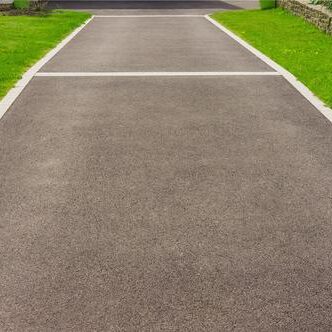How should you care for your new asphalt driveway immediately after a professional installation? Take a look at these tips to help you to maintain your driveway and keep it in top shape.
Wait to Drive on the New Surface
You may hear words such as curing and drying in reference to your new asphalt driveway. These are two separate parts of the post-installation process. Most asphalt driveways take between six and 12 months to fully cure. While you can drive over the area during this time, you do need to pay special attention to the surface.
As the asphalt cures, don’t park on the same area for extended periods of time or consistently. The surface of an uncured driveway is still somewhat soft and pliable. Avoid heavy objects that could pierce the surface, such as motorcycle kickstands or some lawn and garden equipment.
Even though it can take months for the driveway to fully cure, it only takes a few days (depending on the weather and other related factors) to dry. Don’t drive on the surface for the first three to five days after installation. If you have to walk on the driveway, wait at least 24 hours before you step foot on the surface.
Care for the Edges
Improper care can cause the edges of your new asphalt driveway to crack. Don’t drive on the far sides of the asphalt. This includes more than just your car. Avoid the sides of the driveway when you move your lawn mower, bike, or other vehicles.
After installation, you may notice that the edges of the asphalt are exposed. This is normal, but requires attention. If you leave exposed edges as-is, the asphalt can crumble or flake — especially if you accidentally drive over it. Backfill the sides with topsoil (not soft potting soil) or a hardscaping material, such as crushed stone.
Keep the Surface Clean
Remove debris and spills quickly. A fall driveway installation can result in leaf and other plant debris littering the area. Gently remove leaves (or other fall yard waste) from the surface. Avoid metal rakes and other similar sharp tools. These can damage the still-uncured surface. Instead, safely sweep the debris away with a broom.
If your car leaks oil, gasoline, or another substance, clean the spill as soon as possible. If the spill puddles, use non-clump cat litter or sawdust to soak up the excess liquid. Remove the litter or sawdust and dispose of it properly. Spray the area with a hose or use a mild cleanser to scrub the surface. Rinse the area again with a hose and allow it to air dry.
Seal the Surface
A sealant coating can add to your driveway’s durability and extend its lifespan. A properly sealed driveway may resist damage and cracking. This means lower overall costs on repairs or replacement.
Even though a sealant can save you money over time, you shouldn’t consider this process immediately after a new installation. Talk to your asphalt contractor about wait times and potential products to use down the road. While there are sealant products available in retail home improvement stores, this is not a do-it-yourself job for novices.
As your driveway cures, it hardens and the oils in the asphalt evaporate. Wait until the driveway has cured before you seal it. Again, this could take up to 12 months. If you wait longer than one year to seal your driveway, and there are cracks or other signs of wear, contact a contractor to make the necessary repairs first.
Do you need a new asphalt driveway? Contact Arrow Blacktop and Masonry, Inc., for more information.

